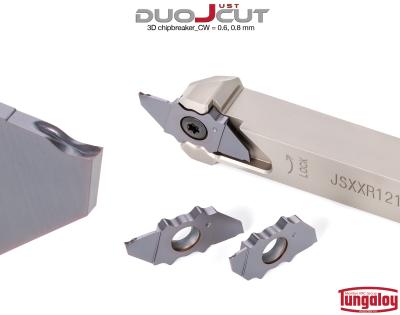Contact Details

Tungaloy has announced the expansion of its DuoJust-Cut parting, grooving, and threading tool line with 0.6 mm and 0.8 mm width parting inserts.
DuoJust-Cut features an innovative insert clamping system that provides insert rigidity for superior parting, grooving, and threading operations performed predominantly on Swiss-type machines.
New parting inserts are offered in the JXPS style : a 0.6 mm (.024″) width insert is designed for maximum parting diameter (CUTDIA) of 6 mm (.236″) and a 0.8 mm (.031″) width insert for 12 mm (.472″) CUTDIA, both furnished with pressed chipbreaker. This intricate chipbreaker creates optimally compressed and curled chips, allowing excellent chip evacuation and superior surface finish. Also, having the thinnest insert width that is commercially available on the market, the inserts remove the least amount of material necessary in every parting process. This helps save material waste for reduced machining costs.
A total of four new inserts are introduced in this expansion in versatile SH725 grade that is designed for a variety of steel and stainless steel machining. A combination of a dedicated coating layer and tough carbide substrate provides the grade with exceptional reliability and long insert tool life.
Related Glossary Terms
- chipbreaker
chipbreaker
Groove or other tool geometry that breaks chips into small fragments as they come off the workpiece. Designed to prevent chips from becoming so long that they are difficult to control, catch in turning parts and cause safety problems.
- grooving
grooving
Machining grooves and shallow channels. Example: grooving ball-bearing raceways. Typically performed by tools that are capable of light cuts at high feed rates. Imparts high-quality finish.
- parting
parting
When used in lathe or screw-machine operations, this process separates a completed part from chuck-held or collet-fed stock by means of a very narrow, flat-end cutting, or parting, tool.
- threading
threading
Process of both external (e.g., thread milling) and internal (e.g., tapping, thread milling) cutting, turning and rolling of threads into particular material. Standardized specifications are available to determine the desired results of the threading process. Numerous thread-series designations are written for specific applications. Threading often is performed on a lathe. Specifications such as thread height are critical in determining the strength of the threads. The material used is taken into consideration in determining the expected results of any particular application for that threaded piece. In external threading, a calculated depth is required as well as a particular angle to the cut. To perform internal threading, the exact diameter to bore the hole is critical before threading. The threads are distinguished from one another by the amount of tolerance and/or allowance that is specified. See turning.





